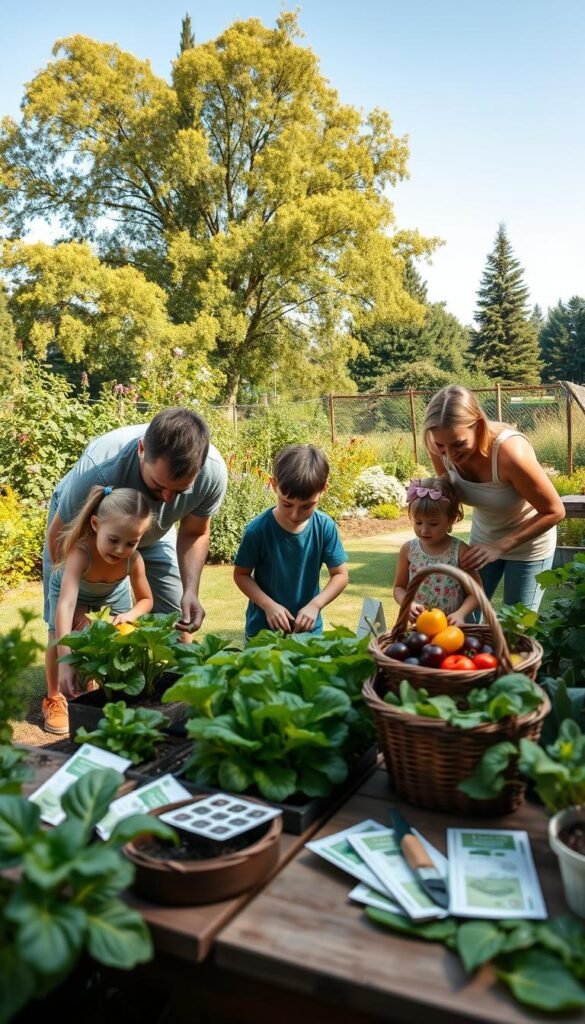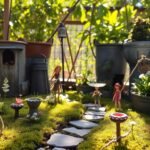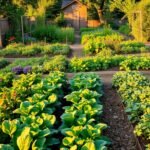What if your backyard could become a vibrant classroom? Digging into soil, planting seeds, and watching life sprout offers hands-on lessons that textbooks simply can’t replicate. For families teaching at home, this timeless activity bridges education and adventure while keeping children engaged.
Imagine blending science experiments with math challenges outdoors. Measuring plant growth teaches fractions. Observing pollinators introduces biology. Even young minds grasp concepts faster when they’re touching, seeing, and doing—not just reading about them.
You’ll find that growing food together strengthens family bonds. Kids take pride in nurturing seedlings into ripe tomatoes or crunchy carrots. These moments build responsibility and patience—skills that last far beyond harvest season.
Best of all, it’s a screen-free way to learn. Fresh air and sunshine replace tablets and TVs. Children discover how ecosystems work firsthand, sparking curiosity about environmental care. Every weed pulled or watering can filled becomes a chance to connect with nature’s rhythms.
Ready to turn your yard into a living lab? Let’s explore how this simple hobby can enrich your daily routine—and maybe even put homegrown veggies on your dinner table!
Getting Started with Garden-Based Homeschooling
Transform your outdoor space into a living textbook where every plant tells a story. Whether you have acres or just a sunny windowsill, nature offers endless ways to enrich your homeschool curriculum. The key? Start small and let curiosity lead the way.
Why Gardening Fits Your Homeschool Curriculum
Digging into soil isn’t just play—it’s applied science. When kids count seeds or track growth rates, math becomes tangible. Botany lessons come alive as they compare leaf shapes or watch roots develop in clear containers. Even art finds its place through nature sketches or flower press projects.
Begin with fast-growing plants like beans or marigolds. These sprout quickly, keeping young learners hooked. Over time, your garden becomes a launchpad for discussing weather patterns, ecosystems, and seasonal changes—all while meeting core educational standards.
Preparing Your Garden Space and Tools
You don’t need fancy gardening tools or a sprawling yard. A few pots, kid-sized gloves, and a watering can work wonders. Choose durable, lightweight tools sized for little hands—plastic trowels and short-handled rakes prevent frustration.
Designate a corner of your patio or balcony as the learning zone. Raised beds or vertical planters save space and reduce mess. Let children decorate their plant markers, turning preparation into a creative project. Before you know it, your garden becomes the classroom they beg to visit daily.
Using Gardening as a Fun Learning Tool for Homeschoolers
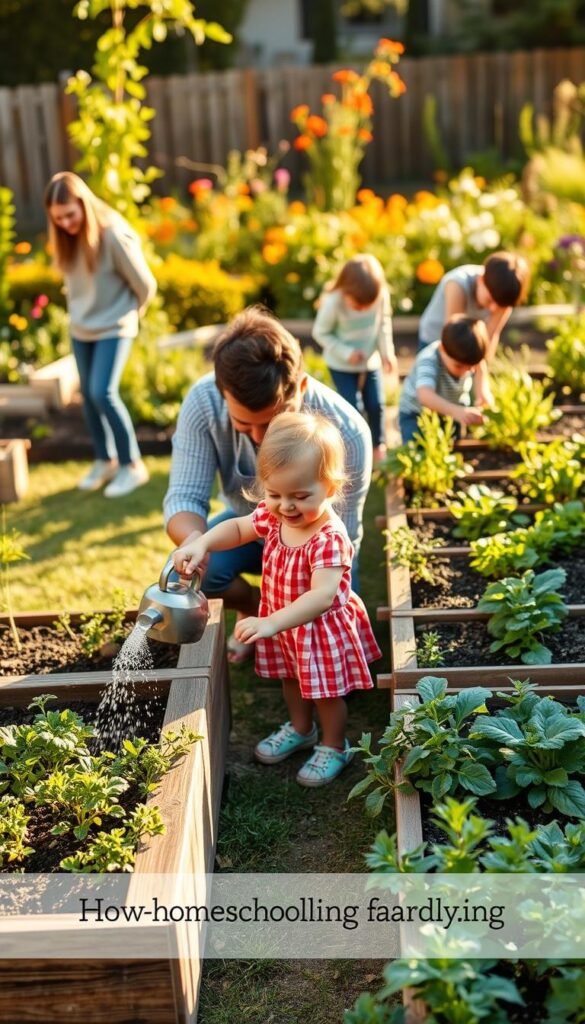
What if every meal could start with a story your kids helped grow? Nurturing plants from seed to harvest does more than fill plates—it shapes attitudes. When children taste their first homegrown cherry tomato, they’re not just eating food. They’re savoring months of care and discovery.
You’ll notice picky eaters suddenly interested in kale salads or roasted zucchini. Why? Pride changes everything. Research shows kids who grow veggies are 5x more likely to eat them. This hands-on approach to food education beats lectures about nutrition every time.
Beyond the dinner table, your family gains:
- Environmental awareness: Spotting earthworms teaches soil health
- Patience practice: Counting days until sprouts appear
- Problem-solving skills: Troubleshooting aphids or thirsty plants
Gardening naturally pulls kids away from screens. Instead of YouTube tutorials, they’re studying real-life science in your backyard. Our favorite homeschooling gardening projects turn these moments into lasting memories—like building bean teepees or crafting herb-infused playdough.
Best of all, you’ll watch gratitude bloom. When children see how nature transforms tiny seeds into meals, “thank you” takes on new meaning. Every watering can emptied or weed pulled becomes a shared victory—one that grows your family bond along with your crops.
Hands-On Learning Through Planting and Science

Ever wondered how a single seed holds the blueprint for an entire ecosystem? Digging into plant life cycles turns your garden into a dynamic lab. Kids don’t just memorize stages—they live them, from sprouting stems to buzzing pollinators.
Exploring Plant Life Cycles and Nature Studies
Watch eyes widen as seeds split open and roots reach downward. Tracking growth phases builds deeper understanding than diagrams ever could. When cosmos flowers attract butterflies, it’s not just pretty—it’s a masterclass in symbiotic relationships.
Try this: Plant marigolds beside veggies. Your study of companion planting becomes a real-world pest control lesson. Journals fill with sketches of leaf veins and bee behaviors, making biology tangible.
Incorporating Math, Measurements, and Observation Skills
Rulers become magic wands when measuring sunflower stalks weekly. Calculate spacing between carrot rows using multiplication. Even snack time turns educational—halve a homegrown apple to discuss fractions.
| Garden Task | Math Skill | Science Connection |
|---|---|---|
| Measuring growth | Fractions/Decimals | Photosynthesis rates |
| Seed spacing | Multiplication | Root system development |
| Tracking growth rates | Data analysis | Environmental impacts |
Create experiments by altering water amounts or sunlight exposure. Thermometers and rain gauges transform play into data collection. Suddenly, graphs matter because they predict tomorrow’s beanstalk height.
Outdoor Activity and Physical Wellness in the Garden
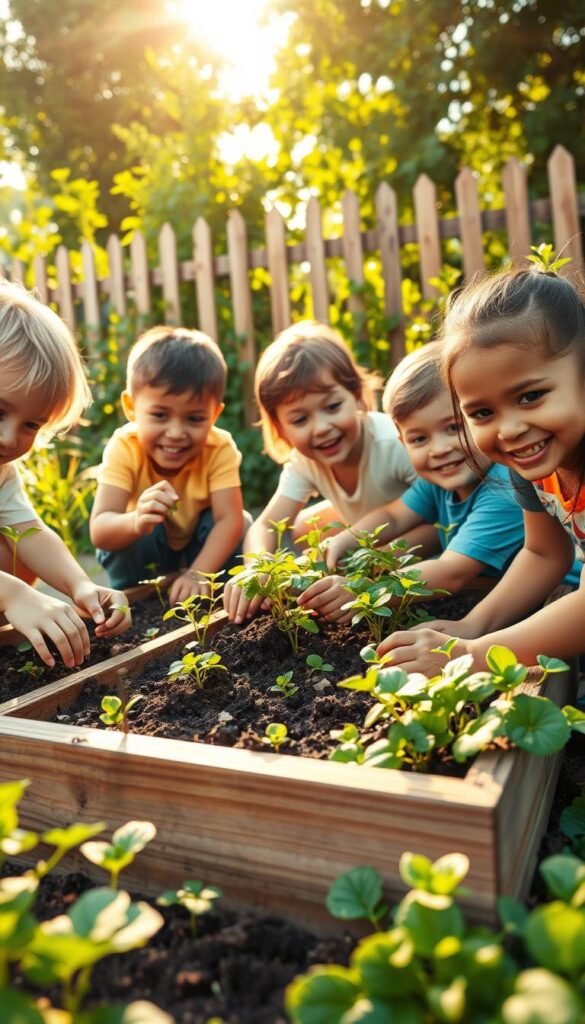
Swap screen time for sunshine—your backyard becomes a gym where fitness grows alongside zucchini. Digging, planting, and watering aren’t just chores. They’re stealth workouts that build strength while teaching responsibility.
Getting Active and Embracing Fresh Air
Sedentary habits melt away when little hands grip shovels. Each gardening task burns calories naturally. Hauling watering cans strengthens arms. Squatting to weed works leg muscles. Even spreading mulch becomes a full-body exercise.
Sunlight does double duty here. It fuels plant growth and boosts vitamin D levels. Kids absorb nutrients through their skin while nurturing seedlings. You’ll notice moods brightening as fresh air replaces stale indoor environments.
| Activity | Physical Benefit | Skill Developed |
|---|---|---|
| Digging soil | Core strength | Coordination |
| Planting seeds | Hand-eye precision | Fine motor control |
| Carrying harvests | Arm endurance | Balance |
Try easy seed-starting projects to kickstart movement. Children love measuring growth while bending, reaching, and stretching. Over time, stamina improves as they work longer without tiring.
Gardening also teaches energy management. Intense tasks like turning compost alternate with calm observation. This rhythm helps kids self-regulate—a skill that translates to better focus during indoor lessons.
Best part? No one complains about exercise when it’s disguised as play. Muddy knees and dirt-smudged faces become badges of honor. Your family stays active while creating something lasting together.
Infusing Life Lessons and Responsibility into Garden Projects
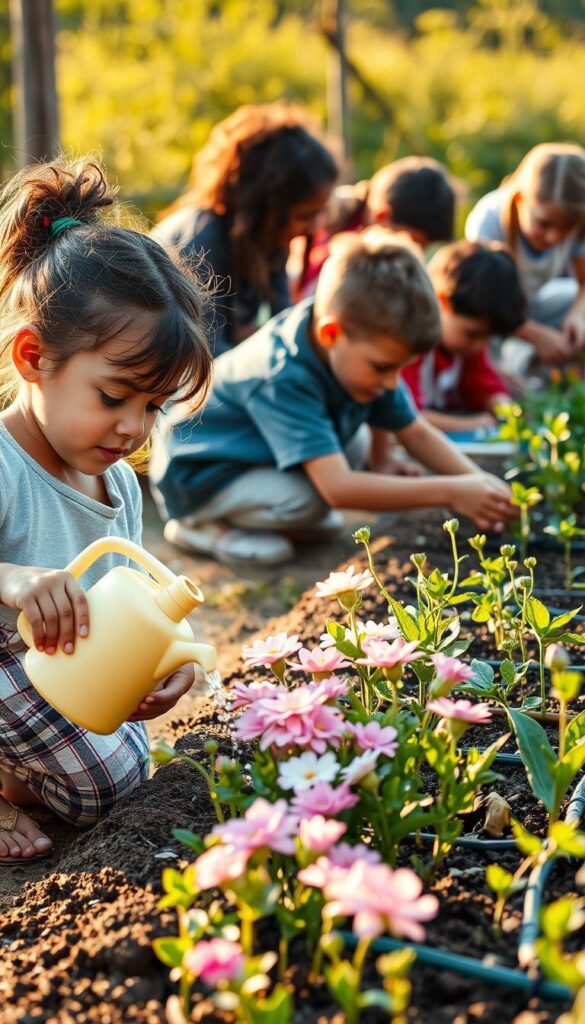
What if chores became character-building adventures? Your family garden transforms daily tasks into powerful teaching moments. Through dirt-stained hands and sun-warmed soil, life skills take root naturally.
Growing Leaders Through Shared Ownership
Let kids claim their plot—literally. Assign specific plants or garden zones to each child. A 7-year-old might champion the carrot patch, while older siblings manage tomato stakes. This ownership builds responsibility as they track watering schedules and spot pests.
Create a task board where children assign roles. Maybe your tween leads compost duty, while your preschooler counts ripe strawberries. Celebrate when they notice wilting leaves before you do—it shows they’re invested.
Nature’s Timer: Lessons in Delayed Gratification
Radishes sprout fast. Pumpkins? Not so much. Mix quick-grow plants with slower varieties. Your kids learn pacing—excitement for bean sprouts today, patience for melons next month.
Try this: Plant sunflower seeds weekly. Compare growth rates while discussing how life’s best things often need time. When blooms finally appear, the payoff feels earned, not given.
You’ll find meltdowns decrease as waiting becomes normal. Forgotten waterings teach natural consequences better than any lecture. Through seasons of growth, your children discover true care means showing up—even when results aren’t immediate.
Creative Homeschool Projects and Garden Activities
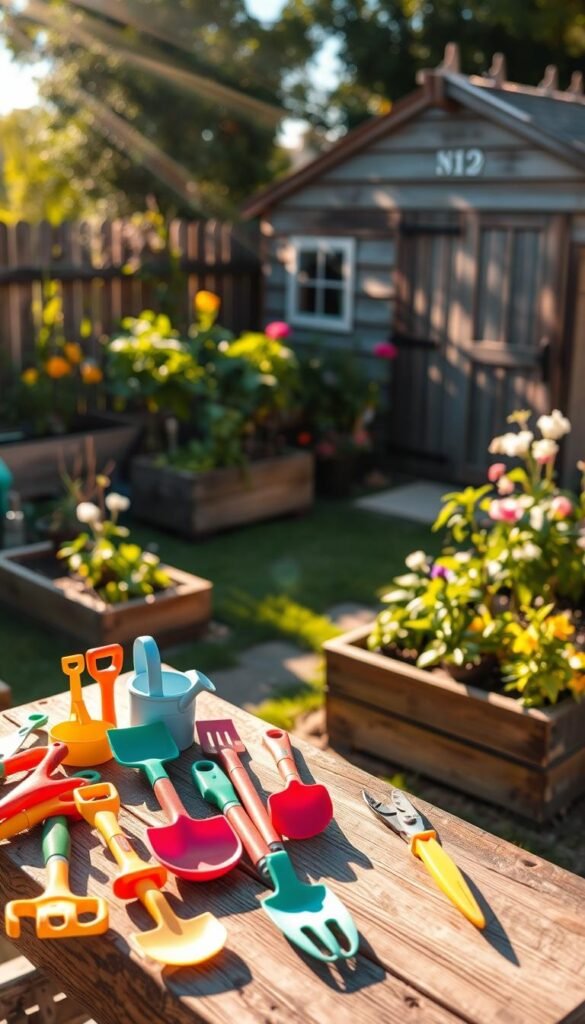
Ever seen a child beam while holding a shovel that fits just right? Properly sized gardening tools transform little helpers into confident growers. When kids wield equipment made for their hands, they focus less on struggling and more on discovering.
Building Confidence With Right-Sized Gear
Adult tools overwhelm small frames. A set designed for kids changes everything. Lightweight trowels and short-handled rakes let them dig and smooth soil without strain. Look for rubber grips that fit snugly in hands—no slipping means fewer frustrations.
Affordable options abound. Basic gardening gloves start under $5, while full sets with rakes and watering cans cost $10-$20. These often come in bright colors that make tools feel personal. Bonus: Small watering cans hold just enough to nourish plants without spilling.
| Tool Type | Child Benefit | Adult Challenge |
|---|---|---|
| Pruners | Safe spring-action | Too stiff |
| Gloves | Flexible fingertips | Bulk material |
| Rakes | Lightweight | Heavy handle |
Turn storage into a craft project. Paint mason jars to hold tools by the door. Let kids decorate their gardening gloves with fabric markers. These touches build pride in their gear—and responsibility to care for it.
Maintenance becomes a teachable moment. Show how wiping dirt off tools prevents rust. Demonstrate oiling hinges on pruners. When children care for their equipment, they learn respect for resources—and the joy of prepared hands ready for next week’s adventure.
Integrating Nature Journals and Educational Resources
Turn garden discoveries into year-round lessons with tools that spark curiosity. Journals and books transform fleeting moments into lasting knowledge, while digital resources keep learning fresh through every cycle of growth.
Using Journals and Books for Extended Learning
Nature journals become treasure maps of your child’s journey. They’ll sketch vegetables at different stages, note which flowers attract bees first, and track rainfall patterns. These records turn casual observations into structured study.
Pair journaling with beautifully illustrated books about plant cycles or soil ecosystems. Titles like “Roots, Shoots, Buckets & Boots” or “The Tiny Seed” make complex concepts digestible. You’ll find these gems on Amazon or at local libraries.
Leveraging Online Resources and Community Support
Digital printables offer instant classroom upgrades. Try these:
- Seed identification flashcards for spring planting
- Sunflower anatomy posters during summer blooms
- Pollinator charts when autumn bees visit
Connect with homeschool groups sharing resources on Pinterest or Facebook. Swap tips about growing heirloom vegetables or preserving flowers. Many offer free study packs aligned with science standards.
| Garden Topic | Printable Resource | Best Season |
|---|---|---|
| Plant Parts | Stem & Leaf Diagrams | Spring |
| Life Cycles | Butterfly Development Charts | Summer |
| Soil Health | Composting Guides | Fall |
Mix physical books with screen-based tools for balanced learning. During winter months, review seeds catalogs together—planning next year’s garden keeps enthusiasm rooted.
Wrapping Up Your Garden Journey with
Imagine stepping back to admire thriving plants your crew nurtured together. That scraggly seedling now towers with tomatoes. Those crooked carrot rows? They’re proof of growth—both in soil and young minds.
Your outdoor classroom did more than teach photosynthesis. It showed how patience turns tiny efforts into big rewards. Kids learned math through sprout measurements. Science clicked when butterflies visited marigolds. Every muddy knee told a story.
These hands-on lessons stick because they’re felt, not just heard. Your family didn’t just grow veggies—you cultivated curiosity. Meals taste sweeter when they start with “I grew this!”
Keep that momentum going. Swap winter lulls with seed catalogs and garden plans. Let last season’s journals inspire new experiments. Remember: every shovel dig plants roots in knowledge that blooms for years.
Your backyard adventure proves education isn’t confined to desks. With dirt under nails and sun on faces, you’ve grown more than plants. You’ve nurtured lifelong learners—and family bonds that weather every season.
